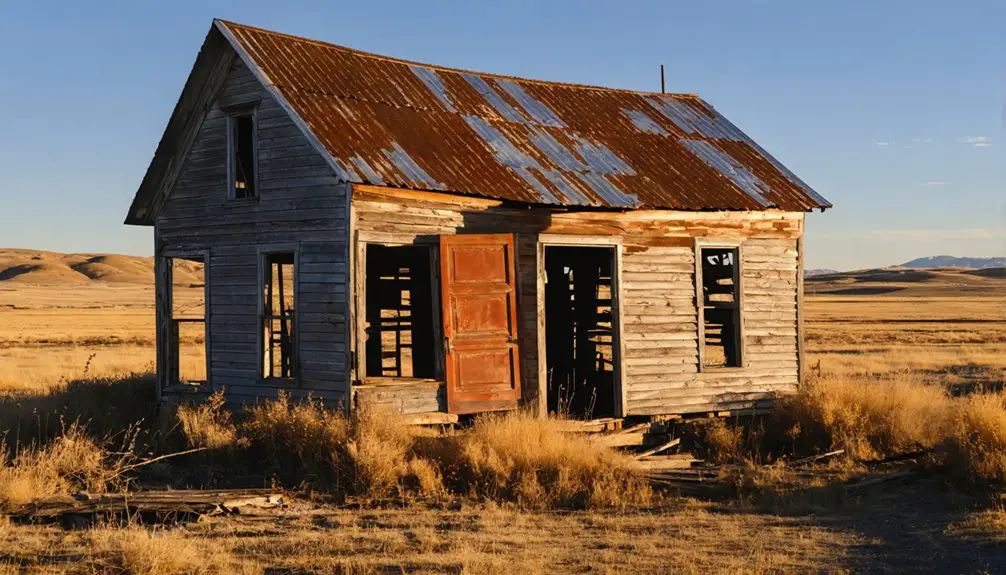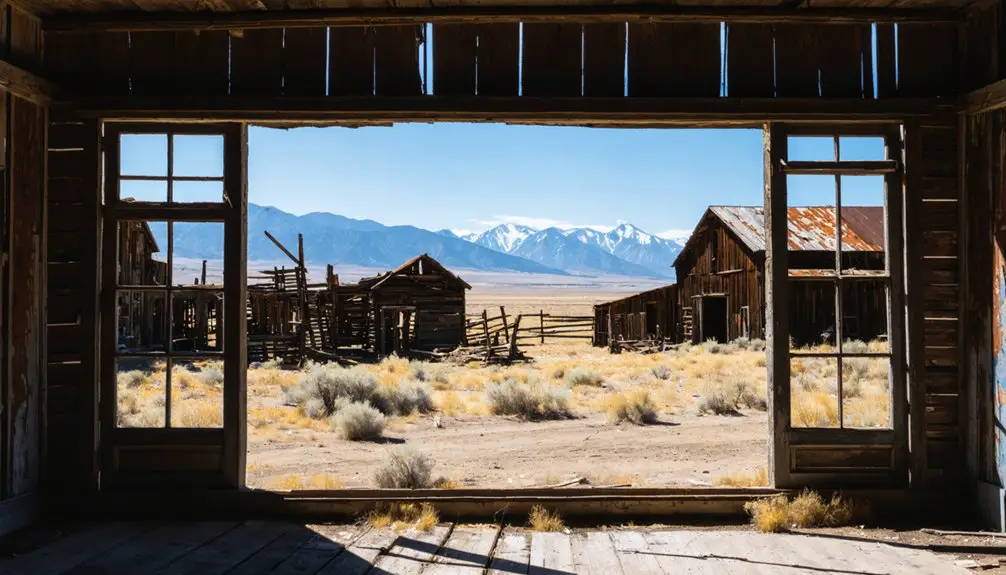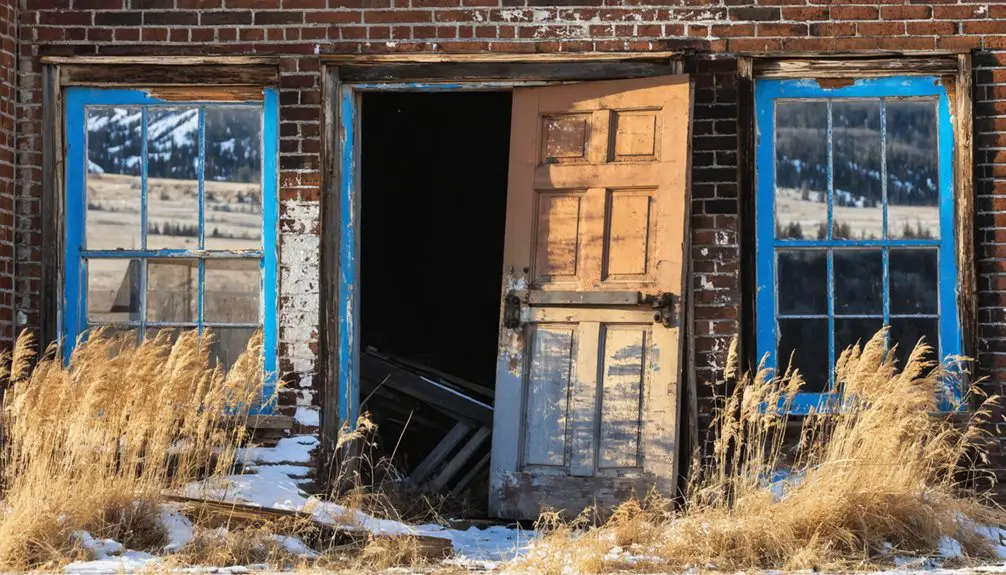You’ll find Storrs, Montana nestled in the Gallatin Valley, where the Anaconda Copper Mining Company established this coal mining settlement in 1902. The town features well-preserved wooden structures, including miners’ homes and community buildings, all arranged in a planned grid pattern. While the mining operations focused on coal production for copper smelting, Storrs couldn’t survive the depletion of its resources. Today’s ghost town reveals fascinating layers of Montana’s industrial heritage waiting to be uncovered.
Key Takeaways
- Storrs was established in 1902 by Anaconda Copper Mining Company as an industrial hub focused on coal mining and coke production.
- The town featured carefully planned wooden houses, modern amenities, and organized street layouts reflecting an efficient company town design.
- Daily life revolved around mining operations, with strong community bonds formed through shared spaces like saloons and the local schoolhouse.
- Economic decline occurred due to depleted coal resources, leading to unsustainable operations and eventual abandonment of the town.
- The ghost town is now protected under preservation initiatives using an “arrested decay” approach to stabilize historic structures.
The Rise of a Montana Mining Settlement
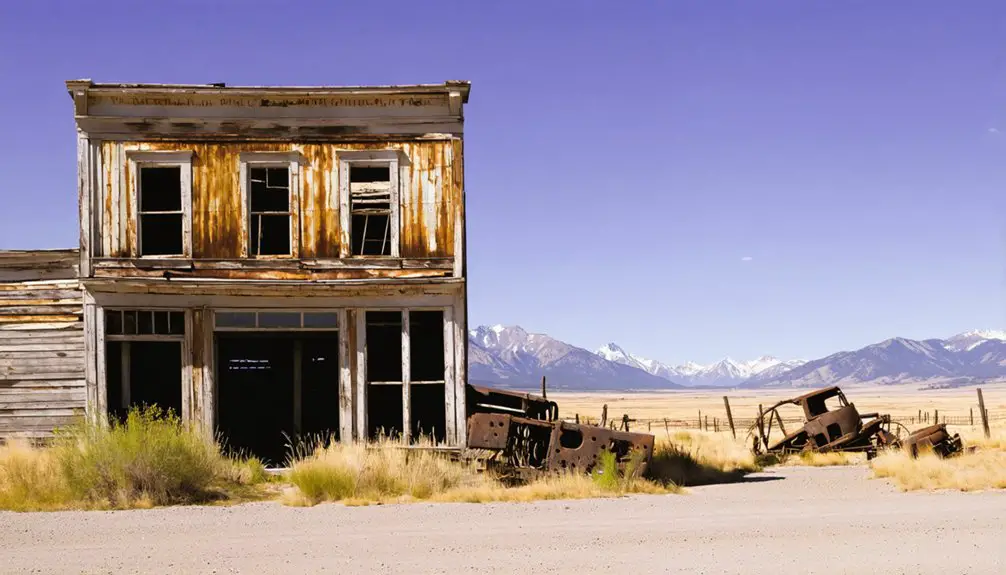
When the Anaconda Copper Mining Company established Storrs in 1902, they created a strategic industrial hub designed to support Montana’s booming copper industry.
Like the early mining camp entrepreneurs who saw business opportunities in growing settlements, various merchants and service providers quickly established shops to serve the Storrs mining community. The charcoal kilns produced essential fuel for the region’s metal smelting operations. You’ll find the town’s origins deeply rooted in the region’s rich coal deposits, where various mining techniques, from strip mining to underground operations, extracted valuable bituminous coal. The company’s decision to build coke ovens transformed Storrs into a crucial link in copper production.
The labor relations were typical of company towns, with Anaconda providing housing and basic amenities for its workforce.
You’d recognize the familiar pattern of industrial expansion as miners and their families settled into company-built homes, creating a community centered entirely around coal extraction and coke production to feed Montana’s hungry smelters.
Life in the Frontier Mining Community
Daily life in Storrs revolved around the demanding rhythms of frontier mining work, where you’d find residents adapting to both industrial schedules and Montana’s unforgiving environment.
You’d witness miners heading to work at dawn, tackling dangerous conditions underground while their families maintained modest homes built for practicality and warmth.
The community’s spirit thrived in local saloons and meeting halls, where mining families gathered to share news and support one another. Just like in Virginia City’s Fraternity Hall, these gathering spaces became the heart of social life.
You’d see children attending the small schoolhouse, which doubled as a venue for community gatherings.
Despite the harsh realities of frontier life, you’d notice strong social bonds forming through mutual aid and shared experiences, with many residents using simple tools like panning and rockers to extract gold.
The town’s resilience showed in how residents helped each other through economic downturns and the challenges of remote living.
Mining Operations and Economic Development
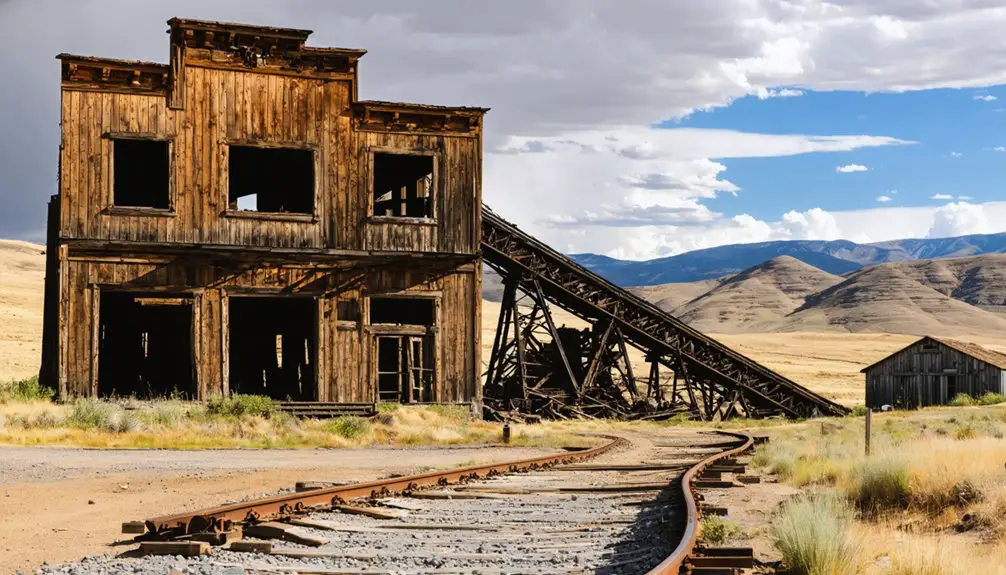
You’ll find the peak mining years in Storrs centered around the 1880s when silver extraction utilized innovative hydraulic methods and underground shaft mining techniques.
The processing facilities included 100 coke ovens that supported the region’s smelting operations, integrating coal and metal mining industries.
The mining boom attracted workers and businesses, spurring the construction of general stores, boarding houses, and transportation infrastructure that temporarily transformed Storrs into a bustling frontier economy. Much like Virginia City’s rapid decline, the town’s prosperity was short-lived, with gold extraction operations generating significant wealth before economic downturn set in.
Peak Mining Production Years
During the late 19th and early 20th centuries, Storrs emerged as an essential coal mining center that fueled Montana’s industrial expansion.
You’ll find evidence of both strip and underground mining techniques that defined the town’s peak production years, when demand for coal and coke soared to support the region’s booming metal processing operations.
The town’s mining companies, particularly those operating in the Great Falls Coal Field, maintained steady coal production to supply vital fuel for Montana’s copper and silver smelters.
While exact production figures aren’t well documented, you can trace Storrs’ prominence through its extensive network of coke ovens and mining infrastructure.
The town’s output remained significant until after World War I, when changing energy demands and new fuel sources led to the decline of smaller mining operations.
Silver Extraction Methods Used
As miners explored Storrs’ rich mineral deposits, they developed sophisticated underground extraction methods tailored to the region’s vein-type silver deposits.
They’d construct networks of shafts and crosscuts to safely access the ore bodies, implementing careful mine design with proper vertical spacing between levels. You’ll find they used overhand stoping techniques, working upward block by block from the lowest levels.
Their silver recovery techniques included crushing and grinding the ore, followed by gravity concentration to separate valuable minerals from waste rock.
They’d then smelt the concentrated ore to extract silver from associated lead, copper, and zinc minerals.
Mining safety practices were integral to operations, with raises providing ventilation and escape routes while also facilitating the systematic division of ore into manageable extraction blocks. Similar to the practices at Montana’s Richest Hill on Earth, these mining methods maximized ore recovery while maintaining worker safety.
Local Economic Infrastructure Growth
The Anaconda Copper Mining Company (ACM) established Storrs in 1902, transforming the Montana landscape from a remote location into a bustling company town centered around coal mining and coke production.
You’ll find that ACM’s strategic economic diversification created robust labor dynamics through their integrated mining operations and coke processing facilities.
The town’s infrastructure grew rapidly to support mining operations, with key developments including:
- Strip and open-pit coal mines that took advantage of shallow deposits
- Extensive coke ovens that processed coal for copper smelting operations
- Worker housing complexes built specifically for miners and plant workers
- Transportation networks linking Storrs to other ACM operations
This infrastructure development sparked secondary economic growth, as businesses emerged to serve the mining community’s needs, creating a self-sustaining local economy that thrived on both mining and supporting industries.
Architecture and Infrastructure
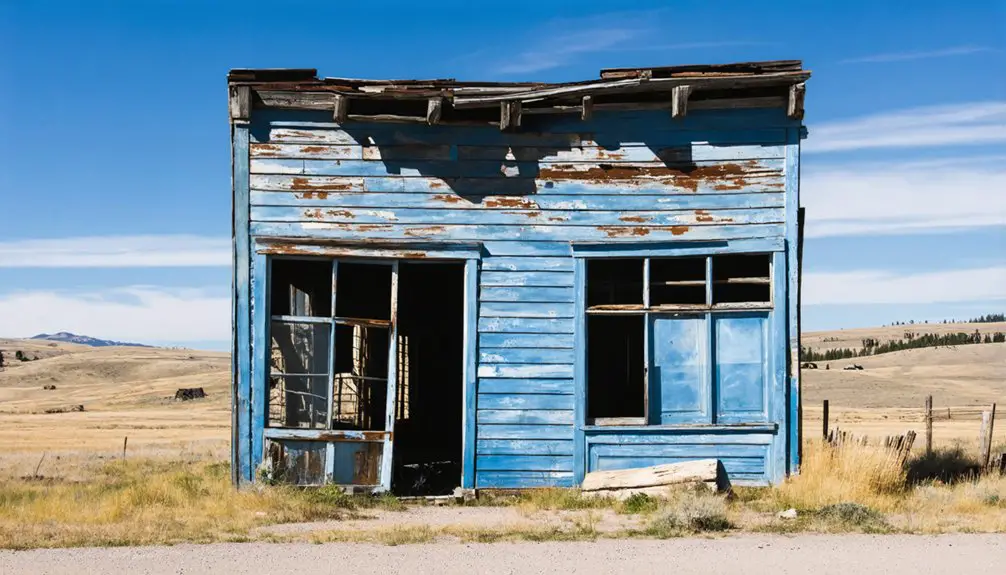
When you examine Storrs’ architecture, you’ll notice the town’s carefully planned blocks featuring painted wooden houses equipped with running water and electricity – modern amenities that set it apart from typical mining settlements of the era.
The infrastructure reflected both efficiency and livability, with streets arranged to provide easy access between residential areas, workplaces, and community buildings like the post office.
The town’s uniform construction style and organized layout demonstrated the coal company’s commitment to creating a model company town that prioritized both functionality and resident comfort. Similar to how original buildings remain in other Montana ghost towns like Bannack, many of Storrs’ structures still stand as testament to early 20th century planning and construction.
Building Materials and Methods
Pioneering settlers in Storrs, Montana relied heavily on locally sourced timber and simple construction methods to establish their mining community.
You’ll find their practical timber sourcing reflected in the hand-hewn logs and rough-cut lumber that formed the backbone of their buildings. Their construction techniques favored speed and efficiency, creating structures that could withstand harsh Montana winters while meeting immediate shelter needs.
Key building features included:
- Dovetail and saddle notch corner joints for stable log cabin construction
- Steep-pitched roofs designed for heavy snow loads
- Strategic hillside integration for natural insulation
- Underground chambers for storage and preservation
The builders’ resourcefulness extended to salvaging materials from abandoned sites, while incorporating simple stone foundations where terrain permitted.
This practical approach to construction guaranteed quick completion while maximizing available resources.
Community Planning and Layout
Although Storrs followed typical Montana mining town layouts, its distinctive grid pattern and strategic positioning of communal buildings created an efficient frontier settlement.
You’ll find the town’s social buildings, like the Masonic hall and schools, positioned as central focal points to enhance community cohesion. These structures served as anchors for residential clusters, while commercial buildings and saloons lined the main thoroughfares. At an elevation of 6,000 feet above sea level, the town’s buildings were constructed to withstand harsh mountain conditions.
The town’s planning prioritized social interactions through thoughtful infrastructure placement. You’ll notice open spaces near public buildings that served as gathering spots, while homes were grouped to share resources and weather protection. Similar to Virginia City, the town featured wooden sidewalks that connected the various districts.
Essential services, including the doctor’s residence, were integrated near the town center, creating a practical community hub that balanced accessibility with the rugged terrain’s constraints.
Social Fabric and Daily Routines
During its peak years from 1902 to 1910, Storrs’ social fabric revolved tightly around the Anaconda Copper Mining Company’s operations, with nearly 500 residents sharing daily routines shaped by the demands of coal mining and coke production.
You’d find strong community connections woven through the town’s various gathering spots and services. The daily rhythms centered on shift work, with miners and plant workers streaming to and from their jobs while support services kept the town running. Like the most isolated town Glasgow, Montana would later become, Storrs developed its own distinct character due to its remote location.
- The hotel and boarding houses served as social hubs where workers gathered after shifts.
- The local store doubled as an informal meeting spot for residents.
- School and post office anchored family life and communication with the outside world.
- The fire station provided essential safety services, reflecting the town’s established infrastructure.
The Decline and Abandonment
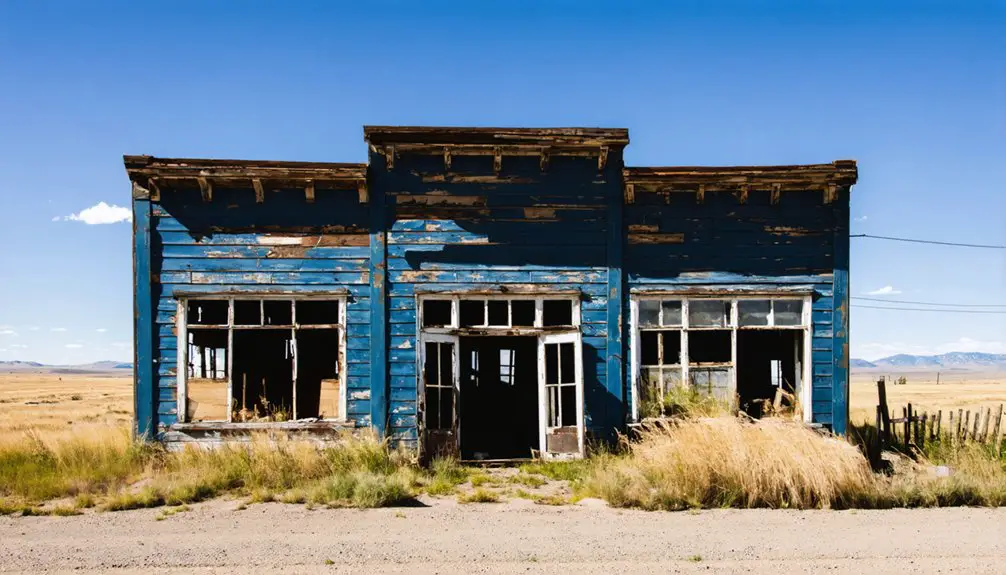
While multiple factors contributed to Storrs’ eventual abandonment, the depletion of local coal resources and subsequent economic collapse served as the primary catalyst for the town’s demise.
You’ll find that economic decline hit hard and fast, as mining operations became unsustainable and expensive to maintain. The town’s remote location and limited transportation access only hastened its downfall, making it difficult for residents to access essential goods and services.
Economic hardship struck swiftly as mining costs soared, while isolation made basic necessities nearly impossible to obtain.
Population migration followed a predictable pattern you’d recognize in other Montana ghost towns – younger residents left first, seeking opportunities elsewhere, while older community members gradually departed as services dwindled.
Without economic diversification to fall back on, Storrs couldn’t sustain itself once the mining industry collapsed, leading to the closure of crucial infrastructure and ultimately, complete abandonment.
Historical Significance in Montana’s Mining Era
The establishment of Storrs in 1902 marked a strategic move by the Anaconda Copper Mining Company to secure reliable fuel sources for their expanding copper operations.
While you’ll find the town’s existence was relatively brief, its historical impact on Montana’s mining era remains significant.
You can understand Storrs’ importance through these key aspects:
- It demonstrated early mining technology integration through its coke production facilities
- The town exemplified the company-controlled community dynamics typical of the era
- It served as a crucial link in Montana’s copper industry supply chain
- The site represented industrial innovation in fuel production despite poor coal quality
As mining technology evolved and transportation improved, Storrs’ story became a reflection of the adaptability required in Montana’s dynamic mining landscape.
You’ll find its legacy preserved in the broader narrative of the state’s industrial development.
Preservation Efforts and Current Status
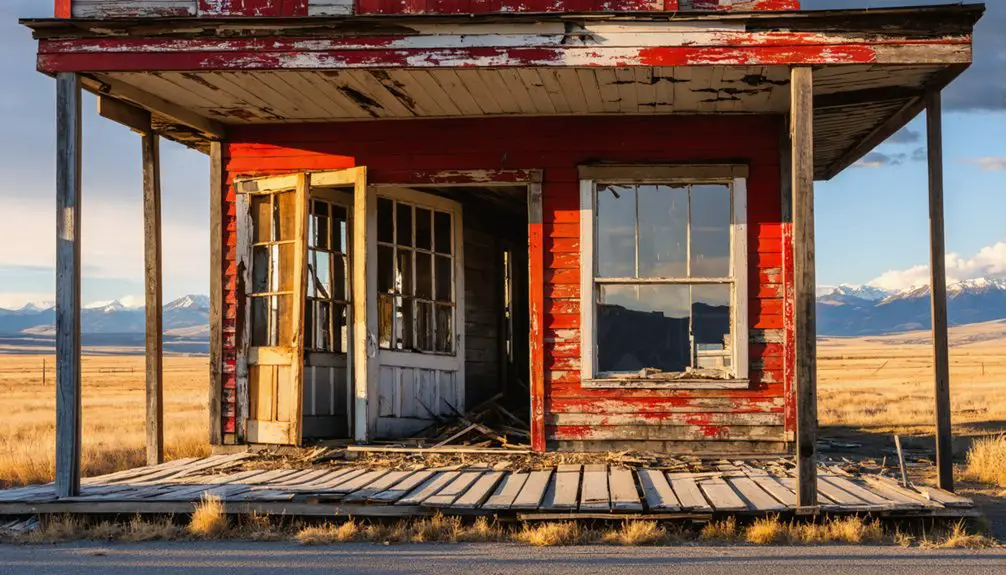
Since Montana’s ghost towns face ongoing threats from weather and vandalism, preservation efforts for sites like Storrs have become increasingly vital.
While Storrs doesn’t receive the same level of active preservation as places like Garnet Ghost Town, it’s protected under broader statewide initiatives through organizations like the Montana Ghost Towns and Preservation Society.
You’ll find preservation challenges amplified by Storrs’ remote location, which makes transporting materials and conducting regular maintenance difficult.
Community involvement remains essential, with volunteers helping monitor the site and conduct educational tours.
The “arrested decay” approach helps stabilize remaining structures without full restoration, allowing you to experience authentic historical elements while ensuring their survival for future generations.
Various preservation societies continue documenting the site’s history and seeking sustainable solutions for its protection.
Exploring the Ghost Town Today
Located deep within Montana’s mountainous terrain, Storrs beckons modern explorers with its weathered remnants of early 20th-century mining life. Your ghost town exploration requires careful maneuvering through rugged terrain, typically demanding a high-clearance vehicle to access the remote site.
Nestled in Montana’s rugged peaks, Storrs stands frozen in time, its mining ruins beckoning adventurous souls to explore its forgotten paths.
When you venture into Storrs, you’ll discover:
- Deteriorating wooden structures that reveal the town’s mining camp origins
- Scattered mining equipment and industrial artifacts that tell stories of frontier enterprise
- Overgrown trails leading to various building foundations and partially standing walls
- Photography opportunities featuring historic ruins against dramatic mountain backdrops
Plan your visit during summer months for ideal accessibility, and bring GPS coordinates since signage is minimal.
You’ll need to rely on self-guided exploration while maneuvering through this authentic piece of Montana’s mining heritage.
Frequently Asked Questions
Were There Any Notable Crimes or Lawless Incidents in Storrs?
You won’t find documented mysterious disappearances or unsolved murders here – historical records show no notable crimes or lawless incidents, making it unusually peaceful compared to other wild Montana mining towns.
What Indigenous Peoples Originally Inhabited the Area Before Storrs Was Founded?
You’ll find the Salish (Flathead) people were the primary Native Tribes living there, with deep Cultural Heritage ties to the Bitterroot Valley region, while Blackfeet, Crow, Kootenai, and Cheyenne also traversed nearby.
Did Any Famous Historical Figures Ever Visit or Stay in Storrs?
You won’t find any famous visitors or people of historical significance in Storrs’ records. The industrial company town focused purely on housing workers for coal mining and coke production operations.
What Happened to the Mining Equipment When the Town Was Abandoned?
When push came to shove, you’d find most mining equipment was hauled away or sold. The abandoned machinery that was too heavy stayed behind, eventually falling prey to scrap metal scavengers.
Were There Any Natural Disasters That Affected the Town’s Development?
You won’t find records of natural calamities directly affecting the town’s development. While harsh mountain conditions created typical environmental impacts, there’s no evidence of specific disasters disrupting the settlement’s progress.
References
- https://getlostinamerica.com/montana-ghost-towns/
- https://www.garnetghosttown.org/history.php
- https://destinationmontana.com/ghost-towns/
- https://www.mountain-home.com/blog/vacation-planning/guide-montana’s-ghost-towns
- https://www.youtube.com/watch?v=BQH5LghhkVs
- https://www.nps.gov/articles/parkscience34-1_13_henderson_et_al_3873.htm
- https://montanakids.com/agriculture_and_business/mining/Early_days_of_Mining.htm
- https://archiveswest.orbiscascade.org/ark:80444/xv647063
- https://deq.mt.gov/files/Land/AbandonedMines/documents/CoalDocuments/GTFCoalField_HistoricOverview.pdf
- https://www.instagram.com/p/C1cQ0uTs-hu/
